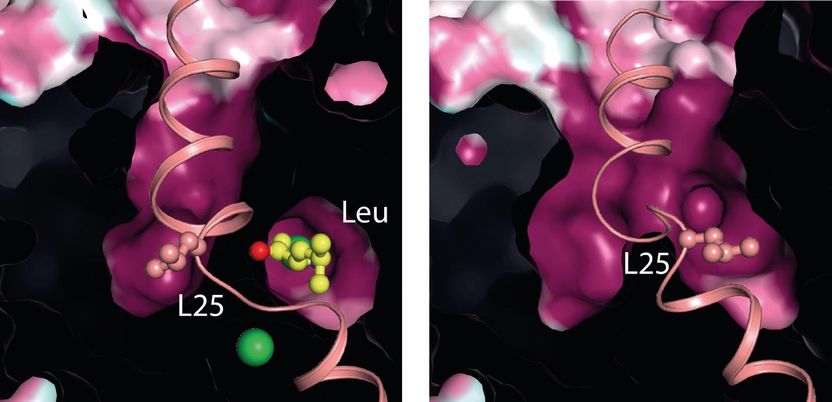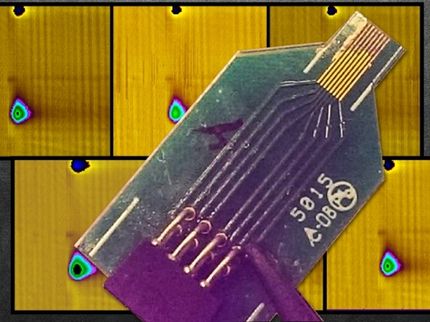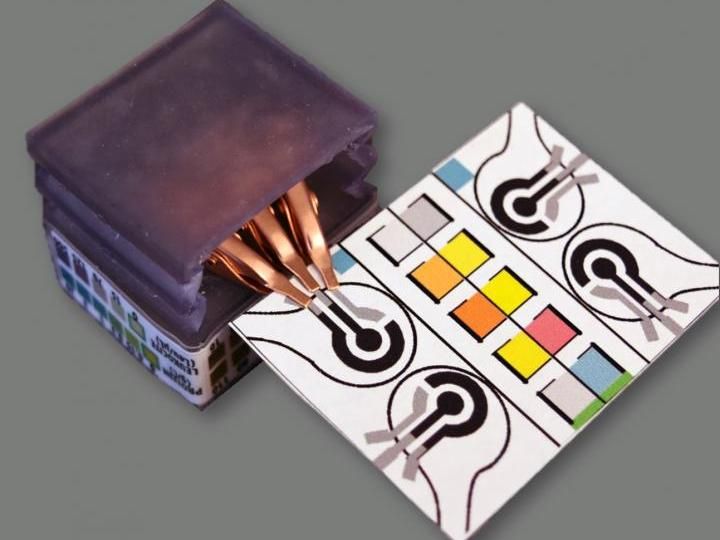New discovery from the molecular machinery for depression and addiction
When nerve cells have to communicate with each other in our brains, it involves release of small signal molecules, the so-called neurotransmitters, which act as chemical messengers in specific points of contact between nerve cells, called synapses. Here the released neurotransmitter is bound and registered by receptors at the surface of the receiving nerve cell. This will, in turn, trigger a signal which is sent on to other nerve cells. The circuits in the brain using the neurotransmitters noradrenaline, dopamine, GABA and serotonin are known to play an important role in mood, reward and mental well-being, and they also have a key role to in mental disorders such as addiction and depression.

The bacterial transporter whose molecular structure has been solved uses the same transport mechanism as the neurotransmitter transporters but instead transports amino acids, such as leucine (Leu). In the outward-oriented state (left) Leu (yellow spheres) binds to two sodium ions (green spheres) in a central binding pocket whereas the rotating unit, designated L25 (beige spheres), is located next to the binding pocket of the transported substance. In the new empty state (right) which the Aarhus researchers have now identified, L25 rotates into the binding pocket where it mimics and compensates for the lacking substance and sodium ions, enabling the transporter to return to an outward-oriented state from which it can start a new transport cycle.
Lina Malinauskaite
After release of neurotransmitters between nerve cells, they must, however, be removed again to end the signal. This is done by a family of transport proteins which function as molecular vacuum cleaners in the cell membrane of the nerve cell where they pump the neurotransmitter back into the nerve cell for later reuse. This transport is of great importance to the signaling between the nerve cells, but happens relatively slowly. A collaborative project between researchers from Department of Molecular Biology and Genetics, Department of Clinical Medicine and Department of Chemistry has made it possible to explain what happens in the crucial rate-limiting step in the transport process for neurotransmitters such as serotonin, noradrenaline, GABA and dopamine which are all transported by related proteins with the same mechanism.
Complicated and energy-consuming transport process
Transport of water-soluble neurotransmitters over a high-fat cell membrane is a complicated process which is challenged in the same way as the mixing of water and oil. The process is furthermore energy-consuming as the transport proteins have to work against a chemical gradient of already accumulated neurotransmitters inside the cell - just as it requires energy to pump air into a bicycle tube. The driving force behind this neurotransmitter's pump process comes from sodium ions which follow the neurotransmitter, but which conversely go from a high concentration outside of the cell to a very low concentration inside the cell. This means that the pump process is driven by the co-transport of sodium ions. For the same reason, it is essential that the transport process does not short-circuit due to sodium ions being transported without a neurotransmitter, or in any other way leak ions.
The neurotransmitter transporter's first task is therefore to bind a neurotransmitter molecule from the outside the nerve cell together with two sodium ions to a binding site in the centre of the protein. When they are in place, the transporter can perform a dramatic movement, closing the binding site towards the outside of the nerve cell and instead opening towards the interior of the nerve cell where the neurotransmitter and sodium are released. To enable the transporter to expose its binding site to the outside of the nerve cell again to carry out a new round of transport, it must, however, first make an opposite movement, i.e. from inward-oriented to outward-oriented but now without neurotransmitter and sodium ions. This change is the rate-limiting factor for how e.g. the serotonin transporter works and it is of great importance for the duration of the neurotransmitter signal. In other words, the transporter tends to remain in this inward-oriented state, and substances such as amfetamine and ecstasy work by highjacking the transporter exactly in this state and make it run in reverse instead, causing it to suddenly and uncontrollably release neurotransmitters instead of removing them.
How the transporters move without ions and neurotransmitter
By solving the molecular structure of a protein closely related to these neurotransmitter transporters, which is captured in a state during the reverse movement from inward-oriented to outward-oriented, it is now clear how the transporter solves the problem of moving without sodium ions and neurotransmitter. A centrally located and completely preserved element of transporters of this family is making a rotation which places this element in the empty binding pocket for neurotransmitters and distorts the binding sites of the sodium ions. Biochemical experiments and computer simulations show that this enables the transporter to revert to the outward-oriented state and at the same time will not bind sodium ions before the rotated element has rotated back. In this way the transporter only utilizes sodium in the forward process and not while reversing this process. Furthermore, the researchers have shown that if this rotating element is changed ever so slightly, the transporter will not work properly and is unable to perform its function.
This new understanding of the mechanism of the neurotransmitter transporters gives hope for better opportunities for treating depression, overdose and addicition, as we now understand better how pharmaceuticals and drugs such as antidepressant, ecstasy and cocaine that bind to these transporters in different states must do so to ensure the right effect.
Original publication
Lina Malinauskaite, Saida Said, Caglanur Sahin, Julie Grouleff, Azadeh Shahsavar, Henriette Bjerregaard, Pernille Noer, Kasper Severinsen, Thomas Boesen, Birgit Schiøtt, Steffen Sinning & Poul Nissen; "A conserved leucine occupies the empty substrate site of LeuT in the Na+-free return state"; Nature Comm.; 2016

























































